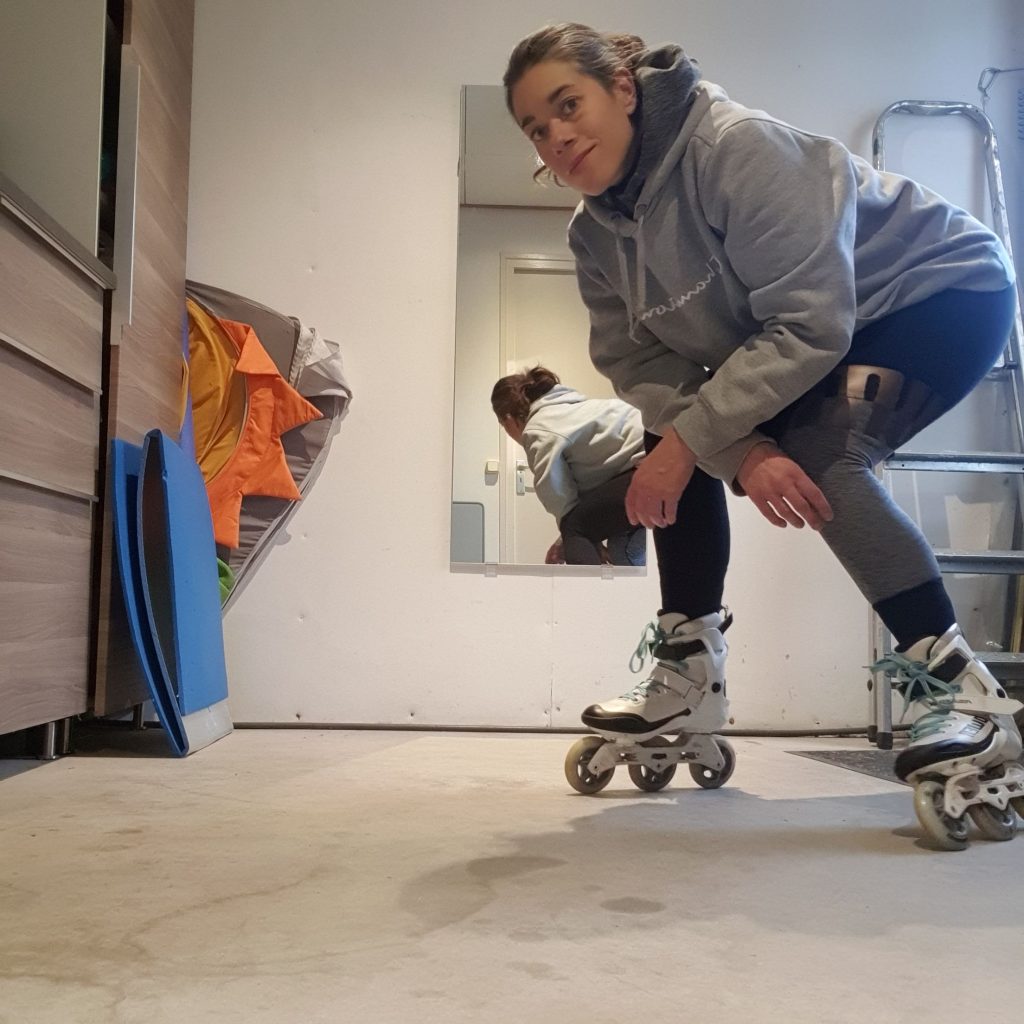Yes, my name is Mrs. Faber. But you can better call me Mrs. Stubborn or even better, Mrs. Impatient. When I started my inline skate adventure last year, I really thought, “oh yeah, I’m really going to rock this sh*t in no time. Haha, so you can also may call me Mrs Unbelievable. And with all this confidence I prematurely removed my heel brake of my skates, thinking it was standing in my way. And I wanted to learn a cool way to brake a.s.a.p.!
But man oh man, this was NOT as easy as my ego thought it would be. For example: this september I had one goal (oh well, more than one, but this one is important for me): to brake in a easy way when going down hill. And as you maybe know, I live in the Netherlands. So “down hill” is more “gentle slope”. And the skill I wanted to learn for this was (and is still) the T-stop.
Do you think I master the T-stop at this moment right now? Well, I do kinda, with small mini steps. But a really long and balanced T-stop? Nope there isn’t. But why not? It is not that I had too little time! I’m inline skating for 9 months now, and I made this certain goal about 4 months ago.
Therefore the subject of this weeks page is: what do I need to succeed. Specifically in making a T-stop for now. And who knows, maybe I (and you) can use these tips for future great plans 🚀
1000 Hours practice
“OK, serious, 1000 hours?”, was my thought (and maybe I said it out loud when nobody was in the room) when @AlexHormozi said in this video: “If you can put a 1000 hours into something, it will probably be pretty good. But the most people put 100 hours into something, oh tssssh most people are even spending less time than that.”
Then I calculated, I’m practicing my inline skating 2 times a week, for about an hour, hour and a half. That is about 150 hours per year roughly practicing my skills. If Alex is right (and I don’t know if he is for sure, but for this time let’s say we trust him), at this rate it will take me around 7 years from now to get “pretty good” 😒
And like you read in my first paragraph, I’m Mrs Impatient plús I’m realizing I’m not 20 years old anymore. So I don’t have the time and the patience to be this patient. So there is only one solution for this:
If you work more, more gets done ~Alex Hormozi
Yes, I have to practice more, duhhhh.
Taking words into actions
But, but, but….I have all these excuses: it’s cold in the winter, in the Netherlands it’s raining all the time and in wintertime after work it’s too dark to skate…….blablabla.
Last week I kicked these sneaky excuses for not practicing in the corner, by creating my indoor (although tiny) excercise area. Doing this this I created the environment (literally) being able to skate more. At least doing my excercises.

My new goal is: go out and skate (really making distances) for 2 times a week AND 4 – 5 times a week repeating certain skills indoor.
During these indoor training I will rehearse the following (at minimum):
- Making lemons 🍋, 100 times in a row. Lemons – I think – are a nice additional technique to slow down in a controlled way and the help me to manouvre around obstables like potholes or hole covers in the road.
And however the lemon looks like an excercise on it’s own. It can lead to some real cool stuff like the lemon cross. But I’m patient, I’m really first training my lemons 😇. This one I’m saving for later.
- T-stops, 100 times in a row. These can be variable. From gently skate dropping in a 90 degrees angle, to practicing short and longer stops.
Practicing these 2 excercises at first I will (hopefully) get a hang of this within (calculating right now 📟), 3 weeks. Wow, that is a significant difference from the years of practice I’ve talked earlier. Sounds great and motivates big time!
Lots (and lots and lots) of good examples
I’m not going to find this whole inline skating out myself. I’m lucky I’m living in this century, when Youtube exists (thank GOD!). Because with all these good examples available online, you can find the instructions you need.
Because it isn’t a good idea to copycat a single person, let’s see which coaches will help me to develop fantastic T-stops.
Ricardo Lino
I already was a fan of him, because he was the one learning me how to carve (curious? read my page about week 3) The good thing about this video is that he cuts all the steps in tiny pieces. This gives you the confidence that you can actually learn this.
Steps from this video I’m focusing on are the following:
- Balancing on one skate 🧘♀️
- Let my drop gently in a 90 degree angle
- Putting more weight on the front skate (80 – 90%!)
Skamidan
In this video I love that there is also attention to posture: knees bend (also the knee from the drag-leg), body to the front to avoid turning and some nice excercises to do without rolling (yet).
Different from Ricardo Lino, SkaMiDan doesn’t let his skate drop after a toe-drag, but he smoothly slides it to the back until he makes an 90 degrees angle (sort of). Plus, what you clearly see in this video, the T-stop is more of an L-stop. The dragging skate is behind but next to the front skate, not really an T stop. And I’m not crazy, Tiago Inline Skater is saying the same in this video.
Bill Stoppard
Bill calls it the drag stop, in stead of the T-stop. Plus for beginners (like me) he zooms in on two points being important:
- Staying low
- One footed stability (like Ricardo Lino emphasises)
Be a one footed coasting machine ~ Bill Stoppard
He’s even mentioning that this drag stop is even more important than my beloved powerstop. Because in traffic and small lanes you need the drag stop.
In the video below you can see that there is less attention for making the 90 degrees angle, a V-shape could be good too. And also with this arms in front he makes that there’s more weight on the support leg while being the one legged skater.
Take home message for me: practice my balance on one leg, “forcing” myself to make longer strides. Second take home message: this skill can be learned in 2 days Bill says, if being consistent. Yay 💯
Small summary
Things that are the most important for the T-, L- or Drag-stop:
- Practice one foot balance!
- Weight on front foot
- Stay straight ahead with your upper body
- Bend your knees, also the dragging skate
- Alternate the dragging skate (this will be soooooo hard on me 😖)
- Stay low
Well, that’s enough to practice for this week (enough for a few haha!). But I’m glad that I found more than one good example so I can make up what’s fits me the best. If you’re practicing too, all the best of luck this week and see you the next one!


